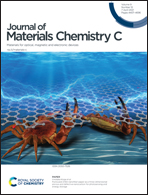All-organic fast intersystem crossing assisted exciplexes exhibiting sub-microsecond thermally activated delayed fluorescence†
Abstract
A novel strategy is presented towards acquisition of exciplex systems exhibiting thermally activated delayed fluorescence (TADF) with a high reverse intersystem crossing (RISC) rate (exceeding 107 s−1). This approach involves constructing exciplex donor–acceptor molecular pairs, where the acceptor molecule possesses the ability to undergo fast and efficient intersystem crossing (ISC). With the use of 6-cyano-9-phenylpurine (PCP) acceptor and carbazole-based donor molecules, exciplexes were obtained, where the excitation is contained on PCP and undergoes fast ISC to form a local excited triplet state (3LEA). The controlled excitation transfer to the 3LEA level provides an optimal reverse intersystem crossing pathway, enabling TADF with a sub-microsecond emission lifetime. The side-effect of such an emissive mechanism is an unusual thermal photoluminescence quenching, caused by the limited PCP triplet state stability under room temperature conditions. PCP-carbazole dyads were obtained, which, in neat solid films, form intermolecular TADF-active exciplexes between donor and acceptor fragments of the neighbouring molecules. These compounds show balanced bipolar charge transport ability and were used as emissive layer host materials. The obtained organic light emitting diode (OLED) with an exciplex-forming host and a TADF emitter showed an external quantum efficiency exceeding 10% and low efficiency roll-off.



 Please wait while we load your content...
Please wait while we load your content...